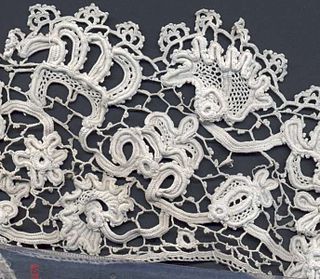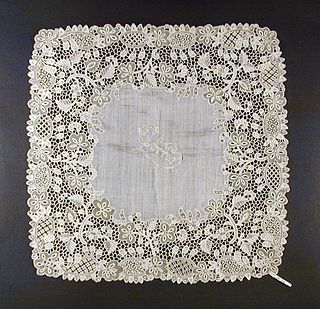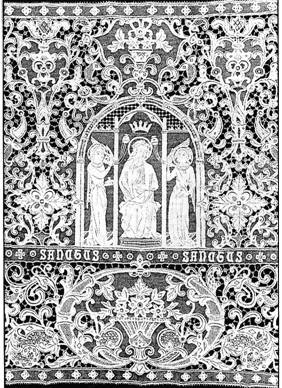
Crochet is a process of creating textiles by using a crochet hook to interlock loops of yarn, thread, or strands of other materials. The name is derived from the French term crochet, meaning 'hook'. Hooks can be made from a variety of materials, such as metal, wood, bamboo, or plastic. The key difference between crochet and knitting, beyond the implements used for their production, is that each stitch in crochet is completed before the next one is begun, while knitting keeps many stitches open at a time. Some variant forms of crochet, such as Tunisian crochet and broomstick lace, do keep multiple crochet stitches open at a time.

Tatting is a technique for handcrafting a particularly durable lace from a series of knots and loops. Tatting can be used to make lace edging as well as doilies, collars, accessories such as earrings and necklaces, and other decorative pieces. The lace is formed by a pattern of rings and chains formed from a series of cow hitch or half-hitch knots, called double stitches, over a core thread. Gaps can be left between the stitches to form picots, which are used for practical construction as well as decorative effect.

Lace is a delicate fabric made of yarn or thread in an open weblike pattern, made by machine or by hand. Generally, lace is divided into two main categories, needlelace and bobbin lace, although there are other types of lace, such as knitted or crocheted lace. Other laces such as these are considered as a category of their specific craft. Knitted lace, therefore, is an example of knitting. This article considers both needle lace and bobbin lace.

Bobbin lace is a lace textile made by braiding and twisting lengths of thread, which are wound on bobbins to manage them. As the work progresses, the weaving is held in place with pins set in a lace pillow, the placement of the pins usually determined by a pattern or pricking pinned on the pillow.

Crochet lace is an application of the art of crochet. Generally it uses finer threads and more decorative styles of stitching, often with flowing lines or scalloped edges to give interest. Variation of the size of the holes also gives a piece a "lacy" look.

Carrickmacross is a town in County Monaghan, Ireland. The town and environs had a population of 5,032 according to the 2016 census, making it the second-largest town in the county. Carrickmacross is a market town which developed around a castle built by the Earl of Essex in 1630. The town won the European Entente Florale Silver Medal Award in 1998. The local Gaelic football and hurling club is Carrickmacross Emmets. The local soccer team is Carrick Rovers.

Tønder lace is a point-ground type of handmade bobbin lace identified with the Tønder region of Denmark since about 1850, although lace of many types has been made there since as early as 1650. The term is also used more broadly, to refer to any bobbin lace made in Denmark.

Point de Gaze is a needle lace from Belgium named for the gauze-like appearance of the mesh ground. It was made from the early to mid 1800s to sometime bertween 1914 and the 1930s.

Youghal lace is a needle lace inspired by Italian needle lace and developed in Youghal, County Cork, Ireland.

Limerick lace is a specific class of lace originating in Limerick, Ireland, which was later produced throughout the country. It evolved from the invention of a machine which made net in 1808. Until John Heathcoat invented a net-making machine in Devon in 1815, handmade net was a very expensive fabric. This meant cheap net became available to Irish lacemakers, particularly after 1823 when Heathcoat's patent expired.

Carrickmacross lace is a form of lace that may be described as decorated net. A three-layer 'sandwich' is made consisting of the pattern, covered with, first, machine-made net and then fine muslin, through which the pattern can be seen. A thick outlining thread is stitched down along the lines of the pattern, sewing net and fabric together. Loops of thread known as 'twirls' are also couched along the outer edge. The excess fabric is then cut away. Some of the net is then usually decorated further with needle-run stitches or small button-holed rings known as 'pops'. Occasionally bars of buttonhole stitches are worked over fabric and net before both are cut away.

A picot is a loop of thread created for functional or ornamental purposes along the edge of lace or ribbon, or croché, knitted or tatted fabric. The loops vary in size according to their function and artistic intention.
The manufacture of textiles is one of the oldest of human technologies. To make textiles, the first requirement is a source of fiber from which a yarn can be made, primarily by spinning. The yarn is processed by knitting or weaving, which turns yarn into cloth. The machine used for weaving is the loom. For decoration, the process of colouring yarn or the finished material is dyeing. For more information of the various steps, see textile manufacturing.

Mountmellick embroidery or Mountmellick work is a floral whitework embroidery originating in the town of Mountmellick in County Laois, Ireland, in the early nineteenth century.

Kenmare lace is a handmade needlepoint lace originally made in Kenmare, Ireland. In the 19th century, sisters of the Poor Clare convent, under the leadership of Mary O'Hagan introduced needlepoint lace to the women and girls of the locality. It was a response to the poverty that followed the Great Famine. The initiative was of immeasurable help to the people of the area in those difficult years.

Lace machines took over the commercial manufacture of lace during the nineteenth century.

Maltese lace is a style of bobbin lace made in Malta. It is a guipure style of lace. It is worked as a continuous width on a tall, thin, upright lace pillow. Bigger pieces are made of two or more parts sewn together.

Irish crochet lace is a style of Irish lace which is generally considered allied to rather than a true lace. It was originally developed in mid-nineteenth century Ireland as a method of imitating expensive Venetian point laces.

Ipswich lace is a historical fashion accessory, the only known American hand-made bobbin lace to be commercially produced. Centered in the coastal town of Ipswich, Massachusetts north of Boston, a community of lacemaking arose in the 18th century. Puritan settlers to the area likely made and wore lace as early as 1634, because Sumptuary laws from the early colonial records indicate this activity. Earliest known records of the commercial production indicate that lace produced by local women was used to barter for goods in the 1760s, as denoted by ledger account books belonging to local merchants. These laces were sold in the region from Boston to Maine.

Milanese bobbin lace is a textile used as a fashion accessory or a decorative trim, first becoming popular in the 17th and 18th centuries in Milan. Lacemaking was an important economic activity in Northern Italy, besides touching on social status matters as well as being a culturally significant art form. The earliest versions of the lace consisted of the tape mostly filling the space. Typical characteristics of Milanese bobbin lace are scrolls made with curving clothwork tapes and floral motifs, and sometimes also consisting of human or animal figures. Sometimes needle lace techniques were combined with the bobbin lace pieces to create the final product.


















